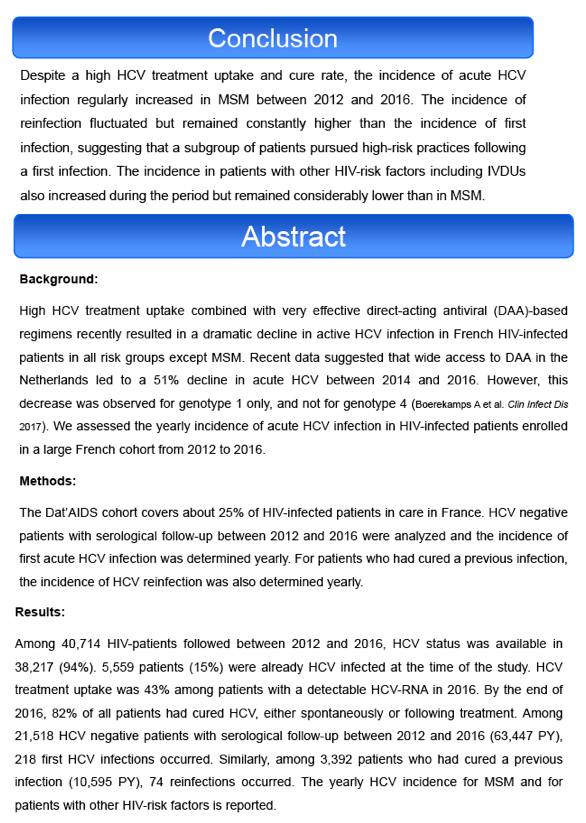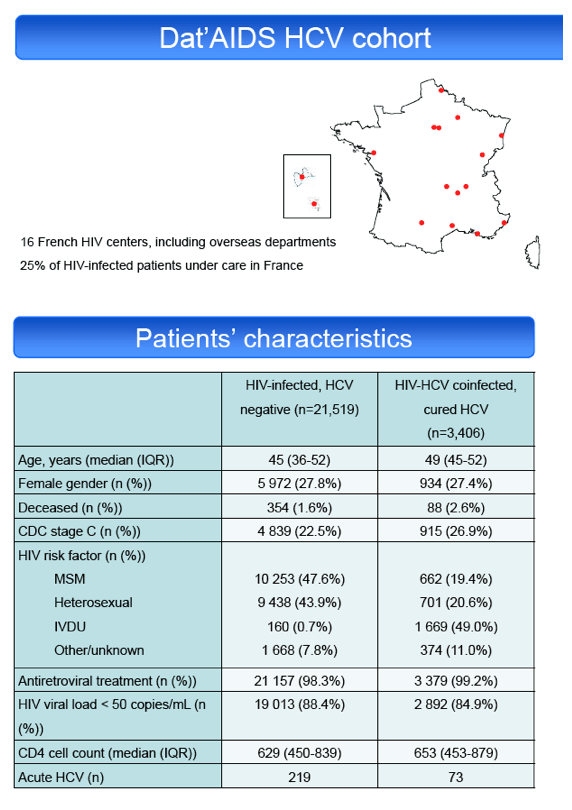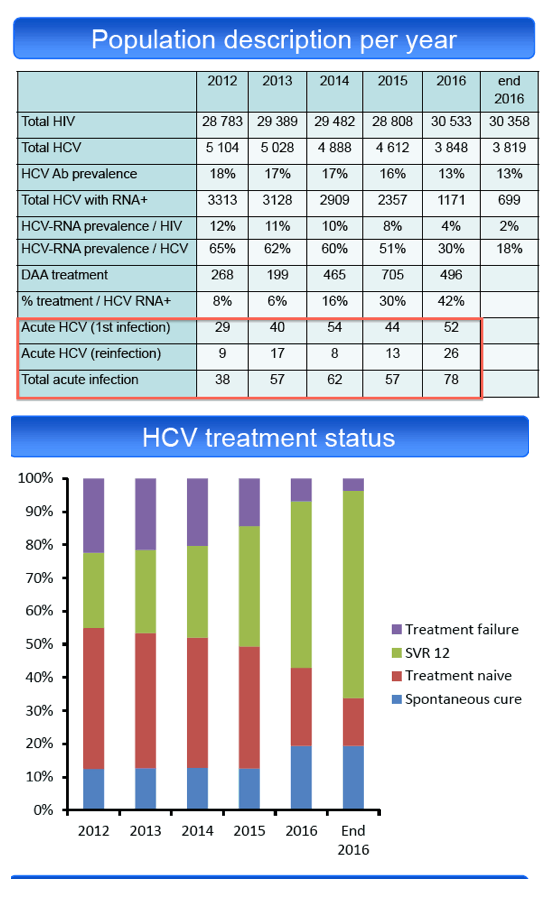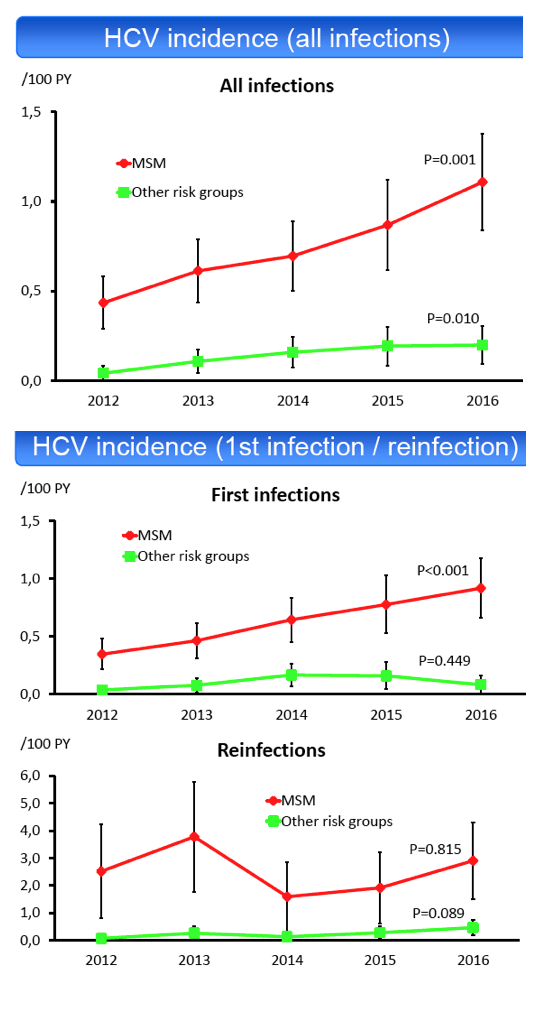 |
 |
 |
| |
New HCV Infections Still Rising Among MSM With HIV in France
|
| |
| |
25th Conference on Retroviruses and Opportunistic Infections (CROI), March 4-7, 2018, Boston
Mark Mascolini
Despite high uptake of direct-acting antiviral (DAA) therapy and high HCV cure rates, incidence of acute HCV infection continued to rise among HIV-positive French men who have sex with men (MSM) from 2012 through 2016 [1]. The reinfection rate more than doubled the new-infection rate in these men.
Recent development and deployment of DAA therapy raised hopes that widespread treatment could greatly limit new infections with HCV. After DAAs arrived, active HCV infection did drop dramatically in many French HIV groups, but not among HIV-positive MSM. Researchers working with the Dat'AIDS cohort, which includes 25% of HIV-positive people in care in France, aimed to update HCV incidence trends in HIV-positive MSM and others.
The analysis involved 38,217 HIV-positive people with known HCV status, 5559 of whom (15%) already had HCV infection. Among people with detectable HCV RNA, 43% began DAA therapy by 2016, and 82% achieved cure either spontaneously or through DAA therapy. Among HIV-positive people cured of HCV, median age stood at 49 and 27% were women. Among cured people, the HIV transmission risk factor was gay sex in 19%, heterosexual sex in 21%, and drug injecting in 49%. Most of these coinfected cured people, 85%, had an HIV load below 50 copies,
HCV incidence (either new infection or reinfection) rose significantly in MSM from just below 0.5 per 100 person-years in 2012 to more than 1.0 per 100 person-years in 2016 (P = 0.001). Among other HIV risk groups, HCV incidence also climbed significantly from 2012 through 2016 (P = 0.01) but peaked at around only 0.2 per 100 person-years in 2016.
The rate of first HCV infections rose significantly among MSM from 2012 through 2016, from below to well above 0.5 per 100 person-years (P < 0.001). Among all other HIV risk groups, the rate of first HCV infections stayed flat at around 0.1 per 100 person-years across the study period (P = 0.449).
Among people cured of HCV infection, the reinfection rate among MSM stood at about 2.5 per 100 person-years in 2012, rose in 2013, fell below 2.0 per 100 person-years in 2014, then climbed again in 2015 and 2016. The overall trend was not statistically significant. Across the study period, the reinfection rate in other HIV risk groups always stayed below 1.0 per 100 person-years. Because the reinfection rate remained consistently higher than the first-infection rate in MSM, the researchers suggested that a subgroup of MSM continued "high-risk practices" after HCV cure.
In contrast to these findings, a study in Switzerland (covered separately by NATAP) produced evidence that wide DAA use halved HCV incidence in HIV-positive MSM [2].
References
1. Cotte L, Huleux T, Raffi F, et al. HCV incidence is still increasing in French HIV-infected MSM. 25th Conference on Retroviruses and Opportunistic Infections (CROI). March 4-7, 2018. Boston. Abstract 591.
2. Braun DL, Hampel BH, Nguyen H, et al. A treatment as prevention trial to eliminate HCV in HIV+ MSM: the Swiss HCVree Trial. 25th Conference on Retroviruses and Opportunistic Infections (CROI). March 4-7, 2018. Boston. Abstract 81LB.
--------------------------------------
HCV Incidence is Still Increasing in French HIV-Infected MSM
Laurent Cotte, Thomas Huleux, François Raffi, Pierre Delobel, Jacques Reynes, Pascal Pugliese, David Rey, Firouze Bani-sadr, Isabelle Poizot-Martin,
Andre Cabie, Antoine Cheret, Claudine Duvivier, Marc-Antoine Valantin, Pierre Pradat and the Dat'AIDS study Group
HCV Incidence is Still Increasing in French HIV-Infected MSM
Laurent Cotte, Thomas Huleux, François Raffi, Pierre Delobel, Jacques Reynes, Pascal Pugliese, David Rey, Firouze Bani-sadr, Isabelle Poizot-Martin,
Andre Cabie, Antoine Cheret, Claudine Duvivier, Marc-Antoine Valantin, Pierre Pradat and the Dat'AIDS study Group





|
| |
|
 |
 |
|
|